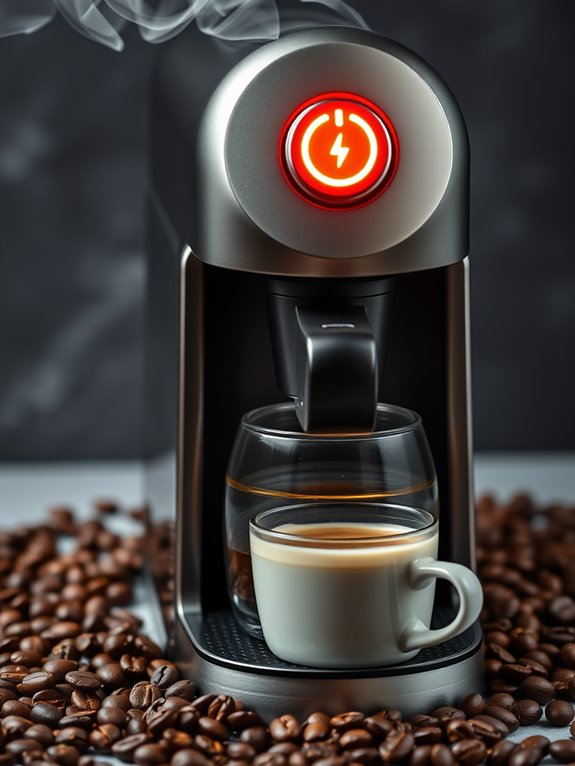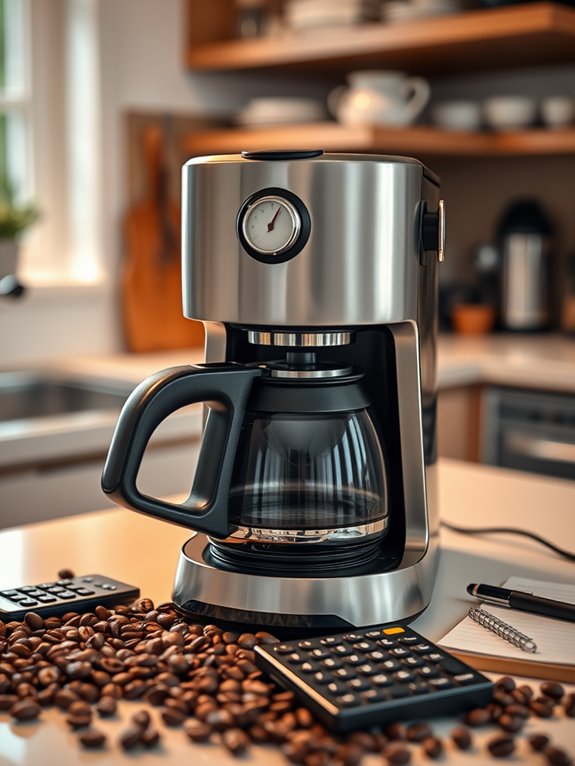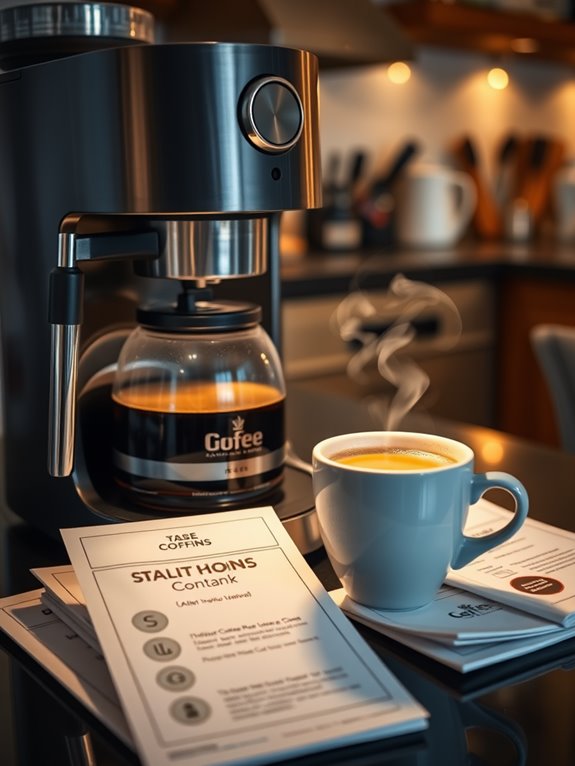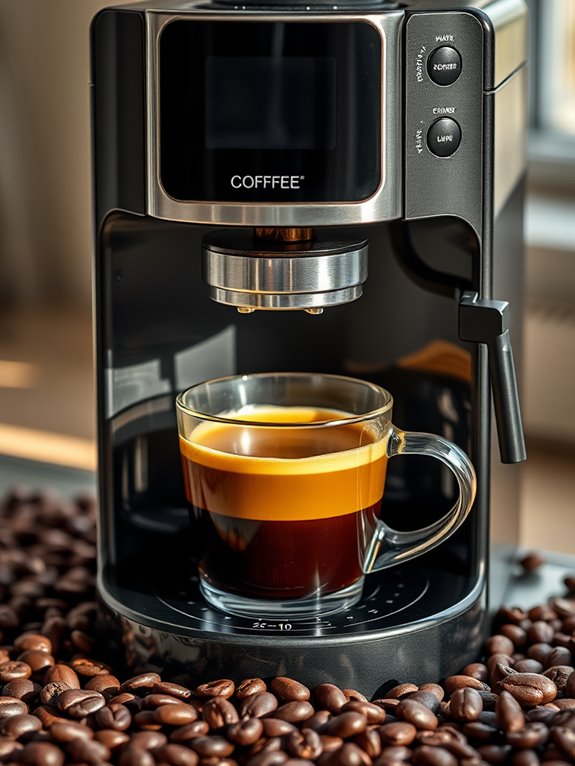Is It Okay to Leave Coffee Maker on
Leaving your coffee maker on isn't a great idea. It poses fire hazards and can inflate your energy bill. Plus, overusing it can shorten its lifespan. Use auto-shutoff features and unplug it when you're done. Regular cleaning and maintenance keep your machine in top shape. If you pick an energy-efficient model, you'll be kinder to the environment and your wallet. Ready to uncover more about safely and efficiently using your coffee maker?
Key Takeaways
- Leaving a coffee maker on increases the risk of fire, especially with older models or malfunctioning sensors.
- Continuous use can raise energy costs significantly, impacting both your budget and the coffee maker's lifespan.
- Unplugging the machine when not in use enhances safety and reduces unnecessary energy consumption.
- Regular maintenance and cleaning help prevent malfunctions and ensure the coffee maker operates safely.
- Ensure the coffee maker is UL listed and placed on a noncombustible surface to minimize fire hazards.
Understanding Coffee Maker Energy Consumption

Understanding how much energy your coffee maker uses is essential if you're trying to save on electricity bills. Most coffee makers range from 550 to 1500 watts.
Drip coffee makers use between 550 to 1200 watts, while single-serve pod machines can reach up to 1500 watts. Larger machines or those with more features consume more power. On average, a drip coffee maker uses around 2.4 kWh per pot, which can add up to approximately $10.08 monthly at a rate of 14¢ per kWh.
While manual brewing methods require more hands-on effort, they typically use less electricity since they don't need constant power to maintain temperature.
To calculate energy use, multiply the wattage by the hours used daily. Use tools or power labels for precise measurements.
Consider energy-saving tips like using the auto-shutoff feature and unplugging after use. Let's investigate these options to help reduce your energy consumption.
Examining the Safety Concerns of Leaving a Coffee Maker On
When you're focused on reducing energy consumption, it's easy to overlook the safety considerations of leaving your coffee maker on.
Let's examine potential risks and safety measures.
Malfunctions and Fires: Extended use increases fire risks, especially with old machines.
Electrical Hazards: They can pose serious electrical threats by overheating, particularly if the over-temperature sensor fails.
Preventative Measures: Unplugging when not in use is essential. Consider using models with automatic shutoff features.
Regular Maintenance: Clean your coffee maker to prevent issues and check for damage.
Safety Precautions: Confirm it's UL listed and placed on a noncombustible surface to minimize fire hazards.
Periodic vinegar solution cleaning helps prevent dangerous mineral buildup that can affect heating elements and overall safety.
Calculating the Cost of Continuous Coffee Maker Use

Calculating the cost of leaving your coffee maker on continuously involves understanding its energy consumption and the impact on your wallet.
Most coffee makers use 400 to 1400 watts. To find out the cost, multiply your machine's wattage by the hours it runs, then by your local electricity rate per kilowatt-hour (kWh).
For example, a 1000-watt coffee maker used 4 hours daily at $0.12 kWh costs $0.48 per day, totaling $175.20 annually.
Remember, while convenience is appealing, continuous use may increase expenses and affect your coffee maker's lifespan.
Consider energy-efficient models and timers for savings.
For optimal safety and taste, run a hot water cycle before brewing your first cup to ensure cleanliness.
Exploring the Environmental Impact of Coffee Makers
While coffee makers are a staple in many kitchens, their environmental impact is often overlooked.
Let's investigate the factors contributing to this impact.
Coffee Maker Energy Use
- Drip Coffee Makers: They use between 550 and 1200 watts, averaging 72 kWh monthly, costing around $10.08.
- Single-Serve Pods: These use 900 to 1500 watts, with lower monthly usage at 7.5 kWh if used briefly, costing about $1.05.
- Brewing Waste: Single-serve pods generate more waste than options like drip makers.
Reducing Impact
Choose shade-grown coffee, buy local, and compost grounds to reduce waste and emissions. Companies like Illy demonstrate leadership through their sustainable coffee practices that support eco-friendly packaging and direct trade with farmers.
Analyzing Manufacturer Recommendations for Safe Usage

Understanding the manufacturer's recommendations for safe coffee maker usage is essential for both safety and durability.
Most coffee makers aren't built for continuous operation, and manufacturers generally advise against it to avoid overheating and reduce wear.
Many modern models have automatic shut-off features, which help prevent overheating and fires.
Always unplug your coffee maker when not in use to avoid electrical issues.
Regular maintenance, like cleaning and descaling, prevents mechanical failures and maintains coffee quality.
For instance, the Technivorm Moccamaster KBGV Select requires regular maintenance despite its design to prevent overheating.
Let's investigate these guidelines for ideal coffee maker care.
Implementing Best Practices for Coffee Maker Use
Guaranteeing your coffee maker is used properly can greatly extend its lifespan and improve the taste of your brew.
Let's investigate some best practices.
Implementing daily and regular maintenance is essential.
Start by:
- Daily Cleaning: Empty the carafe after each use, clean brew pots, and flush espresso group heads.
- Regular Deep Cleaning: Descend quarterly, inspect bi-annually for worn parts, and clean espresso machine shower screens weekly.
- Preventative Maintenance: Check the water filtration system every 6 to 12 months, replace grinder burrs after 800 to 1,000 pounds of use, and turn off machines immediately after use.
Following these steps guarantees peak coffee maker performance.
Evaluating Energy Efficiency in Coffee Maker Models

When you're thinking about how much energy your coffee maker uses, it's important to investigate the specifics of different models.
Single-serve coffee makers consume more energy, using up to 1500 watts, while drip models are more efficient. They use 100-150 kWh annually, with energy savings potential.
Espresso machines, especially steam versions, are even more efficient, using only 10-30 kWh yearly. Choosing Energy Star models can lead to significant savings, reducing energy by up to 25 kWh per year.
Manufacturers like Ascaso offer models with advanced efficiency, cutting consumption by 67%.
Let's examine how these choices impact your energy use.
Considering the Importance of Regular Maintenance
Although it might seem like just another chore, regular maintenance of your coffee maker is key to its longevity and performance.
Let's investigate how you can keep your machine in top shape.
- Quarterly Tasks: Conduct minor checks and deep cleanings to guarantee ideal temperature and flowrate. This prevents scale build-up and clogs.
- Bi-Annual Tasks: Replace worn-out parts like O-rings and gaskets to avoid failures. Also, inspect the water filtration system for better taste.
- Daily Tasks: Clean the machine to prevent residue, assuring your coffee tastes delicious every day.
Regular care reduces breakdowns and extends the lifespan.
Assessing the Benefits of Automated Features in Modern Coffee Makers

Keeping your coffee maker in good condition is important, but understanding the benefits of modern automated features can enhance your coffee experience to a new level.
Energy Efficiency and Environmental Impact
Automated coffee makers with auto-power-down and enhanced insulation reduce energy use, saving 7-25 kWh yearly, cutting CO2 emissions and lowering costs.
Automation and Convenience
Super-automatic machines brew quality espresso effortlessly, featuring customizable settings and automatic milk frothing.
Touch controls and preset options make these machines user-friendly.
Comparative Analysis
While super-automatic machines offer ease, semiautomatic models require more effort but provide control.
Your choice depends on balancing convenience and hands-on experience.







